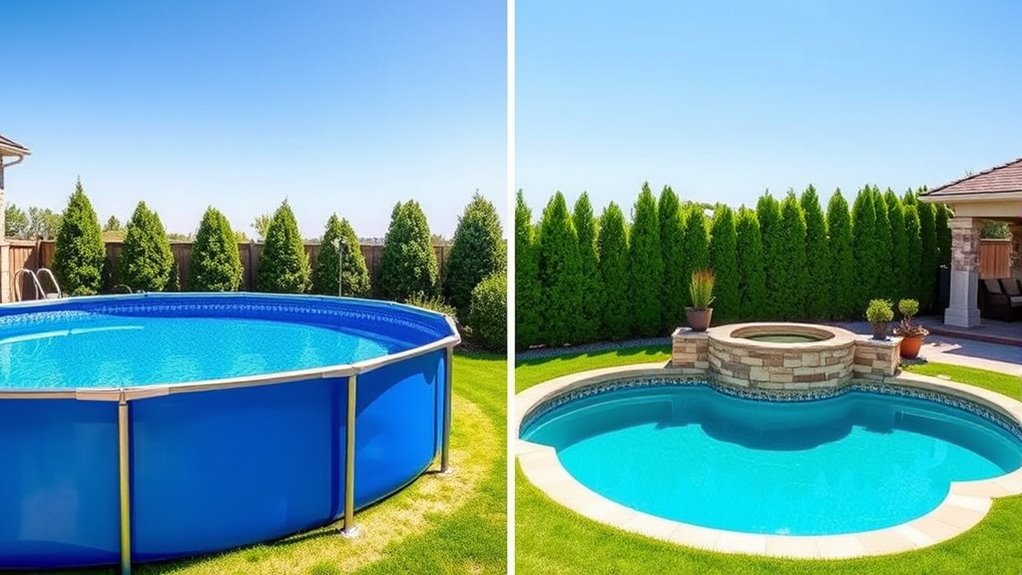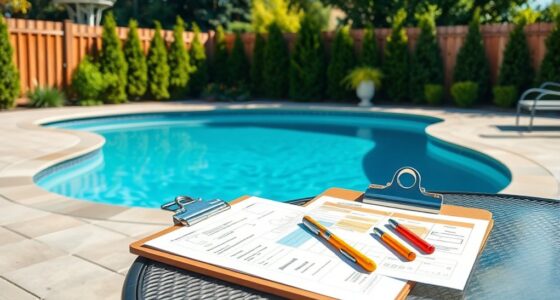In-ground pools offer durability, customization, and a sleek aesthetic that can boost your property’s value, but they come with high upfront costs and longer installation times. Above-ground pools are budget-friendly, quick to set up, and easier to maintain, though they might not add as much value or blend seamlessly into your yard. To decide which fits your needs, consider your budget, desired look, and how long you plan to use it—more details follow.
Key Takeaways
- In-ground pools are more customizable and aesthetically appealing but require higher upfront costs and longer installation times.
- Above-ground pools are budget-friendly, quick to install, and easier to relocate but offer limited design options.
- In-ground pools tend to increase property value and durability, while above-ground pools may negatively impact resale and last around 10-15 years.
- Maintenance costs are higher for in-ground pools due to complexity, whereas above-ground pools generally have lower ongoing expenses.
- Both pools can enhance outdoor entertainment, but in-ground pools provide a more seamless integration with landscape design.
Advantages and Disadvantages of In-Ground Pools

In-ground pools are a popular choice for homeowners seeking a permanent and customizable backyard feature. They add value to your property and allow you to design the pool to fit your style, whether that’s a sleek modern look or a natural lagoon. However, you should consider that in-ground pools require a significant upfront investment, including excavation, construction, and permits. Maintenance can also be costly and time-consuming, involving regular cleaning, chemical balancing, and repairs. Installation takes longer, often several weeks, and there’s limited flexibility once built—you can’t easily move or change the shape. Despite these drawbacks, in-ground pools offer durability, aesthetic appeal, and a luxurious feel that many homeowners find worthwhile. Additionally, choosing the right projector technology can greatly enhance outdoor entertainment experiences around your pool area. Proper planning and pool design considerations can help maximize the longevity and enjoyment of your investment. For example, selecting appropriate materials can improve the pool’s durability and appearance over time.
Benefits and Drawbacks of Above-Ground Pools

Above-ground pools offer a flexible and budget-friendly alternative to in-ground options, making them an attractive choice for many homeowners. They’re quick to install, often within a few days, saving you time and hassle. Maintenance is generally easier and less expensive, with fewer structural concerns. However, there are drawbacks to think about:
- They usually have a shorter lifespan, often around 10-15 years.
- Limited customization options mean less control over shape and size.
- They may not blend seamlessly with your yard’s landscape or aesthetics.
- Resale value can be affected, as some buyers see them as temporary or less durable. Overall, if affordability and convenience matter most, above-ground pools are a solid option—just be aware of their limitations.
Frequently Asked Questions
What Are the Long-Term Maintenance Costs for Each Pool Type?
You’ll find that in-ground pools usually cost more over time due to higher maintenance and repair expenses, like sealing and plumbing upkeep. Above-ground pools tend to be cheaper to maintain, with less complex systems and fewer structural concerns. However, you should consider that in-ground pools may need more frequent cleaning and chemical balancing, which adds to long-term costs, but they also tend to last longer, potentially balancing out expenses over time.
How Does Climate Affect the Durability of In-Ground Versus Above-Ground Pools?
When it comes to climate affecting pool durability, you gotta play it by ear. In-ground pools often withstand extreme weather better, especially in colder climates, since they’re built into the ground. Above-ground pools are more vulnerable to wind and ice damage, which can be a real pain. If you live in a harsh climate, you might need to winterize or reinforce your pool more often to keep it in top shape.
Can You Convert an Above-Ground Pool Into an In-Ground Pool Later?
You can convert an above-ground pool into an in-ground pool, but it’s a complex process. You’ll need to remove the existing structure, excavate the site, and install a new foundation and liner. It’s labor-intensive and costly, often requiring professional help. Before starting, consider if the investment makes sense for your space and budget, as converting can be more challenging and expensive than building an in-ground pool from scratch.
What Safety Features Are Recommended for Each Pool Type?
Ever wondered how to keep your pool safe? For both types, install a sturdy fence with a self-closing, self-latching gate to prevent accidental falls. Use pool alarms to alert you of unexpected entry, and consider safety covers when not in use. Guarantee proper lighting and easily accessible rescue equipment. These features help protect everyone, whether your pool is above ground or in-ground, giving you peace of mind.
How Do Local Building Codes Impact Installation Options?
Local building codes notably influence your pool installation choices by dictating safety standards, zoning restrictions, and permit requirements. You’ll need to check with your city or county before starting construction, as codes may restrict pool size, fencing, or electrical setups. Ignoring these rules could lead to fines or having to modify your pool later. By understanding local regulations early, you guarantee a smooth installation process and a safe, compliant swimming area.
Conclusion
Choosing between in-ground and above-ground pools is a game-changer for your backyard. Imagine hosting endless summer parties or diving into a personal oasis anytime you want—it’s like having your own slice of paradise. Don’t settle for less; your dream pool can transform your life into pure joy and unforgettable memories. So, make the bold choice today and turn your backyard into the ultimate haven everyone will envy!









